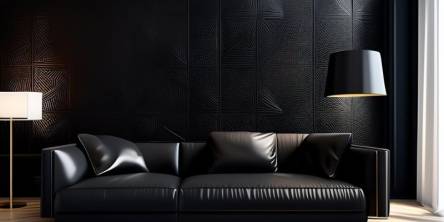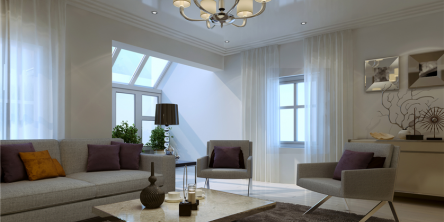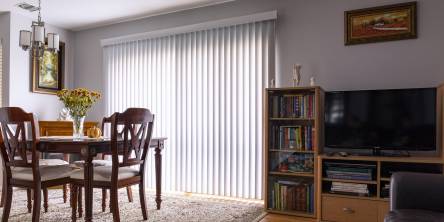Creating a Healthy Home Interior: Transforming Your Space for Wellness

In today's world, our homes have become more than just a place to live. They are now sanctuaries for relaxation, wellness, and a retreat from the fast-paced outside world. Crafting a healthy home interior is about more than just aesthetics; it's about creating an environment that supports both physical and emotional well-being. From using non-toxic materials to incorporating design principles like feng shui, the choices you make for your home can have a profound impact on your overall health.
Prioritizing Air Quality in Your Home
One of the most important aspects of a healthy home is clean air. With many homes being sealed tight for energy efficiency, indoor air quality often suffers. Pollutants like dust, mold, volatile organic compounds (VOCs), and even household cleaning products can contribute to poor air quality.
To improve the air quality in your home:
- Ventilation is key: Open your windows regularly to allow fresh air to circulate. If you live in an area with outdoor pollutants, consider installing air purifiers to capture allergens and toxins.
- Houseplants: Indoor plants like spider plants, peace lilies, and snake plants naturally filter the air. NASA's Clean Air Study even identified these plants as effective at removing toxins like formaldehyde, benzene, and ammonia.
- Non-toxic cleaning supplies: Switch to eco-friendly, chemical-free cleaning supplies to reduce VOCs. Look for products made with plant-based ingredients or make your own using vinegar, baking soda, and essential oils.
Choosing Non-Toxic Furniture and Materials
When it comes to furniture and building materials, many traditional options off-gas harmful chemicals like formaldehyde, flame retardants, and heavy metals. These substances can linger in the air and be absorbed into the body over time, contributing to a variety of health issues.
To create a healthier home:
- Opt for natural materials: Choose furniture made from solid wood, bamboo, or metal rather than particleboard or MDF, which often contain adhesives and chemicals.
- Certified products: Look for certifications such as Greenguard or OEKO-TEX, which ensure that materials and furniture meet rigorous standards for low chemical emissions.
- Sustainable fabrics: Choose natural fabrics like organic cotton, linen, and wool, which are free from harmful dyes and finishes. Synthetic fabrics, especially those that are wrinkle-resistant or flame-retardant, are often treated with chemicals that can negatively affect indoor air quality.
Read more: Basic Elements Regarding Luxury Interior Design
The Importance of Natural Light
Natural light is another essential component of a healthy home. Exposure to sunlight helps regulate circadian rhythms, improves mood, and even boosts vitamin D levels, which is crucial for bone health and immune function.
When designing your home for optimal light:
- Maximize windows: Arrange your living spaces around windows to take advantage of daylight. If possible, install large windows or skylights to flood the room with natural light.
- Light-colored walls: Choose lighter shades for your walls and furniture, which reflect natural light and create a brighter, more open space.
- Sheer curtains: Opt for sheer or light-filtering window treatments instead of heavy drapes that block sunlight. This helps maintain privacy while still allowing light to filter in.
Feng Shui Principles for a Healthy Home
Feng shui, an ancient Chinese practice, emphasizes the arrangement of your living space to harmonize with natural energy forces. Applying feng shui principles to your home can improve not only the aesthetic flow but also the physical and emotional well-being of its inhabitants.
In feng shui, the flow of chi (or energy) is crucial to creating a healthy home. Here's how you can incorporate these principles:
- Declutter your space: In feng shui, clutter represents stagnant energy that can block the natural flow of chi. Remove unnecessary items from your home, especially in high-traffic areas, to create a sense of calm and clarity.
- Balance the five elements: Feng shui is based on the five elements—wood, fire, earth, metal, and water. By incorporating each element into your home through colors, materials, or decorative items, you can create a more balanced and harmonious environment.
- Use mirrors mindfully: Mirrors can help to redirect energy flow, especially in dark spaces. However, be mindful of their placement, as mirrors facing doors or windows can push energy out of the room.
For the bedroom, one of the most important areas in the home for rest and rejuvenation, feng shui principles are especially beneficial. To create a feng shui bedroom:
- Position the bed for balance: Place your bed against a solid wall and ensure it is easily accessible from both sides. Avoid positioning the bed directly in line with the door, which can disrupt energy flow and affect sleep quality.
- Soothing colors: Use soft, calming colors like pale blues, greens, or earthy tones to promote relaxation and restfulness in the space.
- Limit electronics: Keep your bedroom free from electronics such as televisions or computers, as they create disruptive energy and can interfere with sleep.
Creating a Sleep Sanctuary
Sleep is one of the most important aspects of maintaining health, and your bedroom should be a space that promotes deep, restorative rest. In addition to feng shui, there are other ways to ensure your bedroom becomes a true sleep sanctuary.
- Invest in organic bedding: Choose organic cotton or linen sheets, as they are free from synthetic chemicals often found in conventional bedding. Organic bedding is softer and more breathable, allowing for a more comfortable night's sleep.
- Non-toxic mattresses: Many traditional mattresses are made with harmful chemicals like flame retardants and off-gassing foams. Look for natural latex mattresses or those certified by GOTS (Global Organic Textile Standard) to reduce exposure to toxins while you sleep.
- Darken your room: Exposure to light while sleeping can interfere with your body's natural sleep cycles. Consider using blackout curtains or a sleep mask to ensure complete darkness while you rest.
Integrating Nature Into Your Living Space
Bringing elements of nature into your home is another key strategy for promoting health and wellness. Studies show that spending time in nature reduces stress, improves mood, and boosts overall well-being. By incorporating natural elements into your home design, you can create a more relaxing and restorative environment.
- Biophilic design: This design approach focuses on integrating natural elements such as plants, water features, and natural materials into your living space. You can achieve this by using wooden furniture, stone accents, and potted plants to create a serene, nature-inspired environment.
- Natural textures: Incorporate organic textures like wool, rattan, or jute to bring a tactile connection to nature inside your home. These materials not only look beautiful but also help create a grounded, cozy atmosphere.
- Water features: Small fountains or aquariums can introduce the calming element of water into your space, enhancing relaxation and reducing stress.
Mindful Use of Color
Color plays a significant role in the energy and mood of a home. While feng shui touches on the importance of colors aligned with the five elements, it’s also important to choose colors based on how they make you feel. Here’s how different colors can impact your mood:
- Blues and greens: These are calming, restful colors that promote tranquility and focus, making them ideal for bedrooms, bathrooms, or meditation spaces.
- Yellows and oranges: Warm tones like these inspire creativity and joy, perfect for living rooms or kitchens where you want to encourage conversation and activity.
- Neutrals: Soft grays, beiges, and whites create a sense of calm and spaciousness, making them ideal base colors for most rooms.
By thoughtfully integrating healthy materials, natural elements, feng shui principles, and mindful design into your home, you can create an environment that nourishes both body and soul. Whether you're redesigning your bedroom for better sleep or bringing more natural light into your living spaces, each choice contributes to a healthier, more harmonious home.
Similar Articles
Looking for a bold way to elevate your home or office? Black wallpaper is a game-changer.
Making the decision to remodel a bathroom can be an exciting endeavor. However, oftentimes, people fail to realize just how challenging it can be.
Want stylish lighting? Find the perfect neon signs for room decor and turn your home into a vibrant, stylish haven with glowing accents. Get inspired today!
Ready to enhance your decor with a neon retro sign? Don't forget to check out how this vibrant decor piece can create the perfect atmosphere in any room.
Plastic chairs are a top choice for cafes, offering durability, easy maintenance, and cost-effectiveness. Enhance style, comfort, and functionality effortlessly!
At all times, people try to see the beauty around them, to surround themselves with it. The Art Deco style is translated from French as "decorative art" and is associated with luxurious interiors. The European art movement of the twenties is currently experiencing a revival and is very popular worldwide.
Learn how to choose the perfect custom vertical blinds for your space by considering material, light control, décor style, and functionality in this comprehensive guide.
Learn the best practices for choosing window coverings for every room, balancing style, privacy, lighting, and insulation. Improve your home's comfort and aesthetics.
Learn how to paint veneer furniture with this step-by-step guide. From prepping to applying the perfect finish, transform your furniture with ease and style









